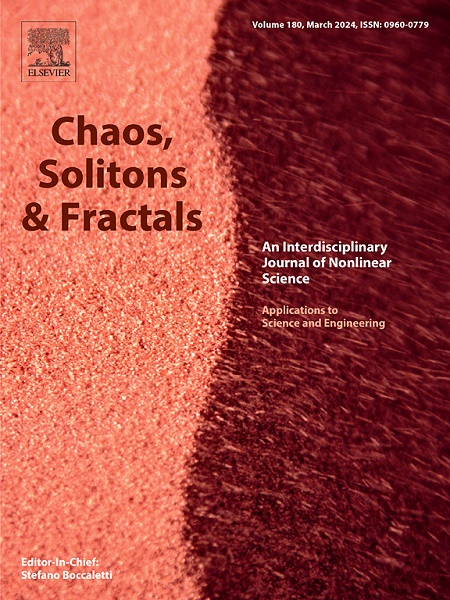高阶网络自适应重布线机制驱动的流行病动力学
IF 5.6
1区 数学
Q1 MATHEMATICS, INTERDISCIPLINARY APPLICATIONS
引用次数: 0
摘要
本研究探讨了自适应简单复杂网络中易感-被感染-易感(SIS)模型的动力学,结合高阶相互作用以更好地捕捉群体层面的传染。通过引入自适应重布线机制,易感节点可以切断与被感染邻居的链路,然后重新连接到其他易感节点,动态重塑网络拓扑,从而有效减缓疫情的传播。采用两两近似方法推导感染密度的解析表达式,考虑适应性重新布线和高阶相互作用之间的相互作用。数值模拟验证了理论预测,表明适应性重组显著降低了感染密度,同时提高了流行阈值。理论和实验结果表明,高阶相互作用放大了双稳态动力学,导致无病和流行状态之间的突然转变。适应性重新布线减轻了两两传播,但在抑制由强群体相互作用驱动的传染方面表现出有限的功效。这些发现强调了高阶结构和网络重新布线适应在重塑流行病结果中的关键作用。提出的框架为流行病湮灭控制策略的设计提供了新的见解,强调了在流行病建模中集成高阶相互作用和网络重新布线适应的重要性。本文章由计算机程序翻译,如有差异,请以英文原文为准。
Epidemic dynamics driven by adaptive rewiring mechanism on higher-order networks
This study investigates the dynamics of the susceptible–infected–susceptible (SIS) model on adaptive simplicial complex networks, incorporating higher-order interactions to better capture group-level contagion. By introducing an adaptive rewiring mechanism, susceptible nodes can sever links with infected neighbors and then reconnect to other susceptible nodes, dynamically reshaping the network topology, so as to effectively mitigate epidemic spreading. A pairwise-approximation approach is taken to derive analytical expressions for infection density, accounting for the interplay between adaptive rewiring and higher-order interactions. Numerical simulations verify the theoretical predictions, revealing that adaptive rewiring significantly reduces the infection density and meanwhile lifts up the epidemic threshold. Theoretical and experimental results reveal that higher-order interactions amplify bistable dynamics, leading to abrupt transitions between disease-free and endemic states. Adaptive rewiring mitigates pairwise transmission but exhibits limited efficacy in suppressing contagion driven by strong group interactions. These findings highlight the critical role of higher-order structures and network rewiring adaptation in reshaping epidemic outcomes. The proposed framework offers new insights into the design of control strategies for epidemic annihilation, emphasizing the importance of integrating higher-order interactions and network rewiring adaptation in epidemic modeling.
求助全文
通过发布文献求助,成功后即可免费获取论文全文。
去求助
来源期刊

Chaos Solitons & Fractals
物理-数学跨学科应用
CiteScore
13.20
自引率
10.30%
发文量
1087
审稿时长
9 months
期刊介绍:
Chaos, Solitons & Fractals strives to establish itself as a premier journal in the interdisciplinary realm of Nonlinear Science, Non-equilibrium, and Complex Phenomena. It welcomes submissions covering a broad spectrum of topics within this field, including dynamics, non-equilibrium processes in physics, chemistry, and geophysics, complex matter and networks, mathematical models, computational biology, applications to quantum and mesoscopic phenomena, fluctuations and random processes, self-organization, and social phenomena.
 求助内容:
求助内容: 应助结果提醒方式:
应助结果提醒方式:


